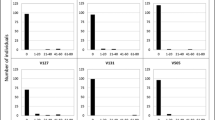Abstract
By repeated retransmission studies four differentBitis species (B. arietans, B. caudalis, B. gabonica, B. nasicornis), whose geographic distribution covers almost all of Africa, were proved to be the final hosts forBesnoitia species. The experimentally infected snakes shed sporocysts measuring 12.0 (11.7–13.1)×8.8 (7.8–9.6) μm. In these experiments, several rodents from the generaMesocricetus, Phodopus, Gerbillus, Meriones, Mastomys andMus turned out to be the intermediate hosts. The inoculation of these mammals with sporocysts excreted byBitis species resulted in macroscopically visibleBesnoitia cysts measuring up to 2.5 mm in the connective tissue of the mammals. These findings may lead us to a new way of thinking as regards research on besnoitiosis in cattle, since it has to be taken into consideration that small mammals may function as reservoir hosts.
Similar content being viewed by others
References
Bigalke A (1981) Besnoitiosis and globdiosis. Curr Top Vet Med Anim Sci 6:429–442
Frenkel JK (1977)Besnoitia wallacei of cats and rodents: with a reclassification of other cyst-forming isosporoid coccida. J Parasitol 63:611–628
Häfner U, Matuschka FR (1984) Life cycle ofSarcocystis dirumpens sp.n. with regard to the host specificity. Z Parasitenkd (in press)
Hoare CA (1933) Studies on some new ophidian and avian coccidia from Uganda, with a revision of the classification of the Eimeriidea. Parasitology 25:359–388
Matuschka FR (1979) The AfricanBitis nasicornis (Shaw 1802) as final host of an unknownSarcocystis species. Salamandra 15:264–266
Peteshev VM, Galuzo IG, Polomoshnov AP (1974) Cats — definitive hosts ofBesnoitia (Besnoitia besnoiti). Izv Akad Nauk SSR [Biol] 1:33–38 (quoted from Vet Bull 44:484, 1974)
Rommel M (1975) Neue Erkenntnisse zur Biologie der Kokzidien, Toxoplasmen, Sarkosporidien und Besnoitien. Berl Munch Tierarztl Wochenschr 88:112–117
Rommel M (1978) Vergleichende Darstellung der Entwicklungsbiologie der GattungenSarcocystis, Frenkelia, Isospora, Cystoisospora, Hammondia, Toxoplasma undBesnoitia. Z Parasitenkd 57:269–283
Smith DD, Frenkel JK (1977)Besnoitia darlingi (Protozoa: Toxoplasmatinae) cyclic transmission by cats. J Parasitol 63:1066–1071
Wallace GD, Frenkel JK (1975) Besnoitia species (Protozoa, Sporozoa, Toxoplasmatidae): recognition of cyclic transmission by cats. Science 188:369–371
Author information
Authors and Affiliations
Additional information
This study was supported by a grant from the Ständige Kommission für Forschung und wissenschaftlichen Nachwuchs (FNK) der Freien Universität Berlin to F.R. Matuschka
Rights and permissions
About this article
Cite this article
Matuschka, F.R., Häfner, U. Cyclic transmission of an AfricanBesnoitia species by snakes of the genusBitis to several rodents. Z. Parasitenkd. 70, 471–476 (1984). https://doi.org/10.1007/BF00926687
Accepted:
Issue Date:
DOI: https://doi.org/10.1007/BF00926687




